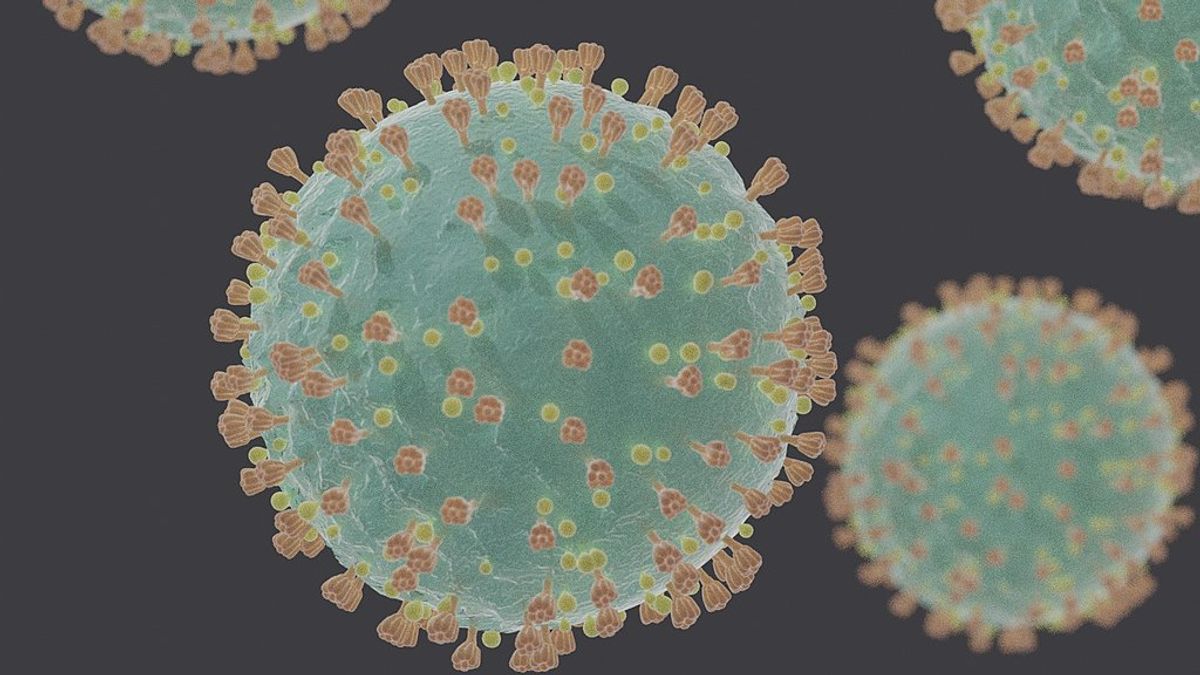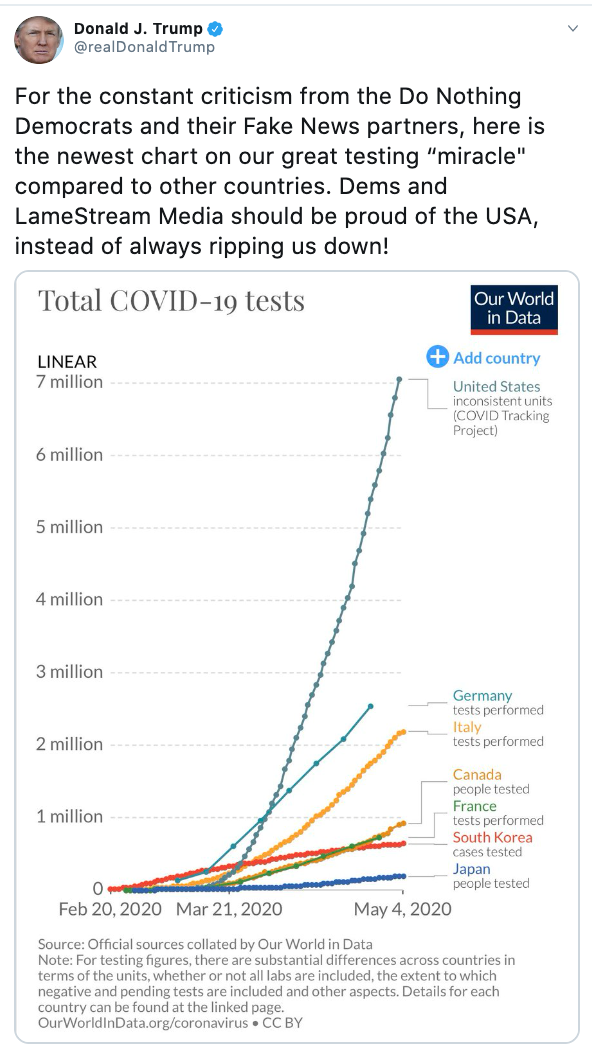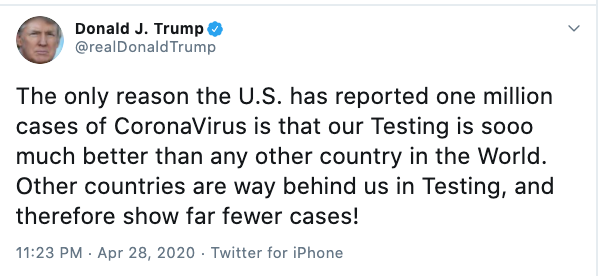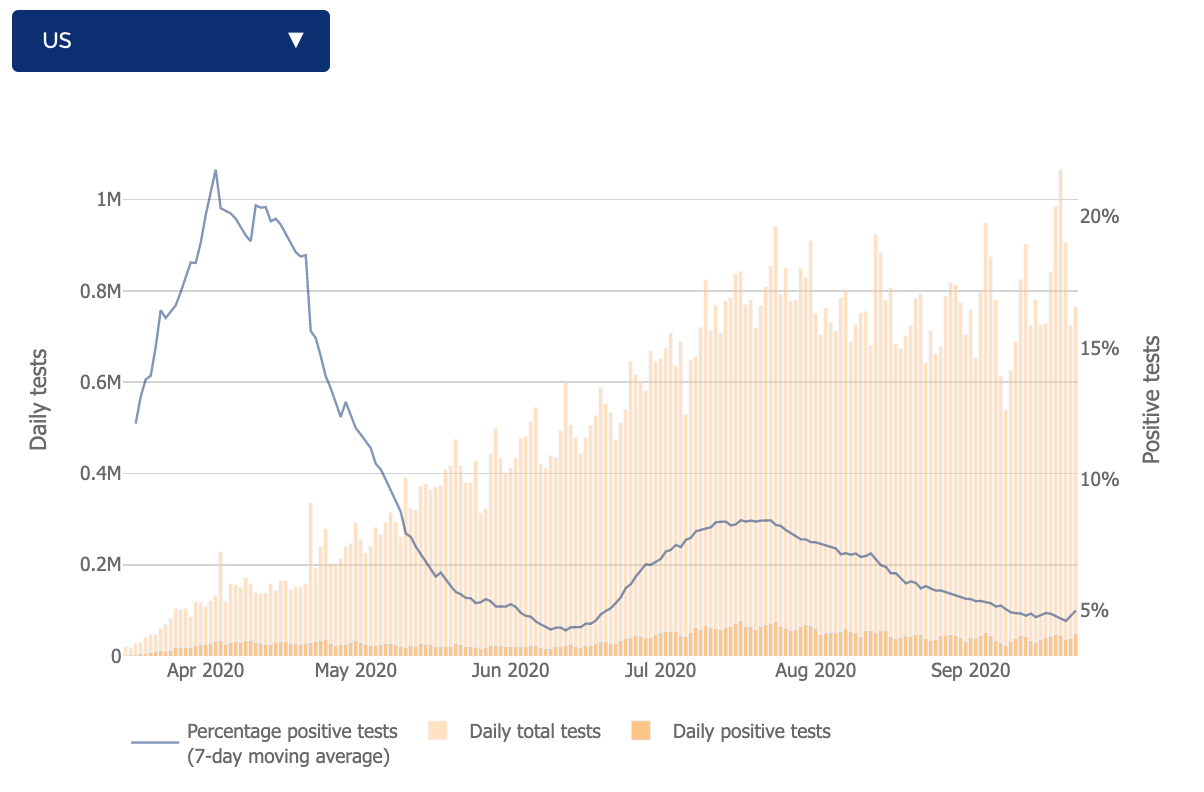Since the early months of the U.S. COVID-19 outbreak in 2020, U.S. President Donald Trump alleged a scheme by his opponents and journalists to purposefully ignore his administration's success with testing Americans for the potentially deadly virus and curbing its spread.
On April 25, for example, Trump tweeted the U.S. had conducted "far more [tests] than any other country in the world" and suggested that news reporters were purposefully keeping that achievement quiet to undermine his office's work to combat the pandemic.
Then, less than two weeks later, the president again made the claim while retweeting a graph that depicted the number of COVID-19 tests performed in Japan, South Korea, France, Canada, Italy, Germany, and the U.S., with the caption:
"[Here] is the newest chart on our great testing 'miracle' compared to other countries."
He doubled down on the alleged conspiracy as the pandemic worsened. The president claimed that not only was the U.S. testing for the virus better than other countries, but also America's skyrocketing case numbers were a direct result of the rate of testing — not the fact that more Americans were passing the virus to one another.
For example, after a July 31 congressional hearing in which Rep. James Clyburn, a Democrat from South Carolina, asked national public health leaders why Europe had largely contained the virus while the U.S. had not, Trump claimed such comparisons were erroneous because "we do MUCH MORE testing" than anywhere else.
The theory spurred a wave of viral posts (like the one displayed below) from Trump's followers and other politicians, all with the same underlying assertion: that the U.S. tallied the highest number of COVID-19 cases globally for one reason: It had tested more residents at a faster rate than any other country.
But, as we'll show below, that argument is flawed because it misunderstands — or purposefully overlooks — the evidence epidemiologists use to measure whether people were indeed stopping the spread of the virus to new people or communities.
Since March 2020, the U.S. Case Total Has Ranked Highest Globally
To begin our analysis, we first considered whether the country had tallied the most coronavirus cases globally, and whether it had tested more residents at a faster rate than anywhere else.
For the former point, Snopes referred to data compiled by Johns Hopkins University that showed the U.S. case load surpassed all other countries’ individual totals beginning in late March (about two months after the first U.S. COVID-19 report), with more than 82,400 confirmed cases at that time. Simultaneously, China, the pandemic's epicenter, recorded about 81,700.
After that, the number of U.S. cases increased and the nation maintained its status as the country with the most coronavirus cases, confirming the basis to the claim.
As of this report, the country has documented more than 6.9 million cases, topping India with roughly 5.6 million cases and Brazil with about 4.6 million. (Note: Per every one million people, Brazil had roughly 22,000 cases — the highest per capita case load globally — while the U.S. ranked second by that standard with about 21,000 cases, according to an analysis of global data by a Nova School of Business & Economics researcher.)
Next, we considered whether it was true that America had tested more residents for the coronavirus than any other country since the start of the pandemic.
According to testing statistics compiled by Johns Hopkins, yes, the U.S. had conducted more tests per capita than any other nation, with a seven-day average of 263 tests per 100,000 Americans, as of late September. That statistic, however, did not consider the size of the outbreaks country-by-country but only measured raw testing numbers per population size. The Johns Hopkins database included the following caveat, as of Sept. 23:
In order for governments to identify new cases and effectively respond to the pandemic through tracing and treatment, testing programs should be scaled to the size of their epidemic, not the size of the population. [...]
[Several] countries effectively controlled the spread of the virus through testing programs that had a far lower number of tests per capita than the U.S. Meanwhile, despite having the highest rate of tests per capita, the U.S. faces the largest outbreak in the world and new cases continue to trend upwards in many states.
Looking at the positivity rate (ie, out of all tests conducted, how many came back positive for COVID-19) is the most reliable way to determine if a government is testing enough. A high rate of positive tests indicates a government is only testing the sickest patients who seek out medical attention and is not casting a wide enough net.
The Rate of Positive Tests Increased, Despite Expanded Testing
Without question, increased testing would reveal more positive cases — that's the nature of probability. However, the president's claim that there is an "x" equals "y" relationship between testing and total cases was misleading and potentially discouraged people from taking the responsibility to make lifestyle changes that would further contain the virus.
First, let us consider the comparison made in above-displayed meme. By giving more people IQ tests, you would not necessarily see an increase in the share of test-takers with low scores. You would likely notice roughly the same results on average if no other conditions, besides more people taking the tests, changed. But if you adjusted for how many people completed the test or how much time they had to finish it — while simultaneously giving out tests to more people — you may see different results overall.
In other words, other factors were at play in the growth of U.S. COVID-19 case numbers, though they were not acknowledged in Trump's tweets. For his claim to be true — that expanded testing was the sole reason for increasing COVID-19 cases in America — the virus would not be spreading to new people or communities, and the proportion of positive tests (within the sum of tests) would decrease, or remain steady, over time.
But according to our analysis of testing data and daily COVID-19 cases, that was not the case.
We'll show you the numbers: In early June, the country was administering an average of about 417,000 tests daily, according to The COVID Tracking Project. Also at that time, about 5.2 tests out of every 100 came back positive, which meant the U.S. tallied about 20,000 new cases each day, per the Johns Hopkins data.
Comparatively, in early September, the U.S. was conducting an average of roughly 760,000 tests daily — which is more than 180% higher than in June, the data showed. But about 5.7% of tests were positive, totaling about 42,000 new cases daily.
As you can see, yes, testing had become available to more Americans over time. But the share of people who tested positive for the virus at times increased — it did not decrease or remain consistent in conjunction with the increased access to testing.
"The fact that the test positivity rate is increasing (in the U.S.) while we're increasing the number of tests is extremely strong evidence that the surge in cases is real," Dr. Justin Lessler, an associate professor at Johns Hopkins, told USA Today, in July.
A similar trend — rising positivity rates amid expanded testing — appeared in examinations of state-level data, too. For example, Florida documented a positivity rate of about 2.6% in early June and more than 12% in early September. Meanwhile, the state's rate of testing at times grew, but at a pace slower than the positivity rate.
Furthermore, a state-by-state analysis in late July by STAT, a news outlet for science stories, found the rate of disease outpaced the expansion of testing in 26 states. "It’s hard to argue that extremely sick people, let alone dead people, had been obscured by low levels of testing but suddenly revealed by higher levels," the report stated.
Caitlin Rivers, an assistant professor at Johns Hopkins, made that point in a series of tweets about a month earlier, writing:
Yes I am aware that testing turns up more cases. That is indeed the point. But in many of the states experiencing a resurgence, hospitalizations are up and the percent of tests that are positive is rising. Those are signs of trouble. [...] It's not just testing.
Put simply, Dr. Sten Vermund, dean of the Yale School of Public Health, told ProPublica if the virus was not spreading, the rate of positive tests with expanded testing would not likely rise. “The tip of the iceberg can’t be growing with the iceberg shrinking,” she said. “It violates laws of physics and oceanography.”
The nation's top immunologist in the U.S., Dr. Anthony Fauci, also attempted to debunk the president's theory on testing. At a June 23 congressional hearing, for instance, after the president told a crowd of supporters that he wanted to "slow the testing down" because it was revealing more COVID-19 cases, Fauci said: "It's the opposite. We're going to be doing more testing, not less. [...] When you get an increase in the percentage of your tests that are positive, that's an indication that you do have additional infections."
In sum, a country's rate of testing is not a fair indicator of a country's ability to contain the virus, which was the basis of Trump's claim. Rather, the rate of positive tests among all screenings was the most reliable way to measure if, or to what extent, a government had effectively limited people's transmission of the coronavirus. And, overall, the country's positivity rate had slightly increased at points between June and September, our analysis of testing and case data showed. For those reasons, we rate this claim "False."






